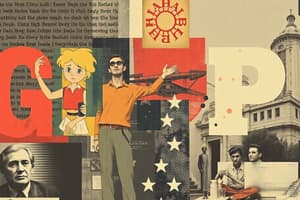Podcast
Questions and Answers
Which of the following best describes the focus of macroeconomics?
Which of the following best describes the focus of macroeconomics?
- The study of economy-wide phenomena, including inflation, economic growth, and business cycles. (correct)
- The stock market performance of individual companies.
- The pricing strategies of individual firms.
- Individual consumer behavior
What are the two main phenomena that macroeconomic models seek to explain?
What are the two main phenomena that macroeconomic models seek to explain?
- Government spending and taxation policies.
- Income inequality and wealth distribution.
- International trade and exchange rates.
- Long-run growth and business cycles. (correct)
What is Gross Domestic Product (GDP)?
What is Gross Domestic Product (GDP)?
- Total government spending in a country.
- The quantity of goods and services produced within a country's borders over a particular period of time. (correct)
- The total value of stocks traded in a country.
- A measure of a country's exports minus its imports.
Into what two components can the time series of GDP be separated?
Into what two components can the time series of GDP be separated?
Macroeconomic models should:
Macroeconomic models should:
Which of the following is NOT a component of the basic structure of a macroeconomic model?
Which of the following is NOT a component of the basic structure of a macroeconomic model?
What is primarily determined jointly by the economy's productive capacity and the preferences of consumers?
What is primarily determined jointly by the economy's productive capacity and the preferences of consumers?
According to the material, what primarily drives improvements in a country's standard of living in the long run?
According to the material, what primarily drives improvements in a country's standard of living in the long run?
What is the main cause of inflation in the long run?
What is the main cause of inflation in the long run?
Which of the following statements is most consistent with the principles of macroeconomics?
Which of the following statements is most consistent with the principles of macroeconomics?
What does per capita real GDP measure?
What does per capita real GDP measure?
What can be inferred about the trend in Canada's government surplus until the early 1990s?
What can be inferred about the trend in Canada's government surplus until the early 1990s?
What policy was introduced in Canada in 1991 to combat the high inflation of the 1970s?
What policy was introduced in Canada in 1991 to combat the high inflation of the 1970s?
Which of the following represents the percentage deviations of real GDP from its trend line, and what does it indicate?
Which of the following represents the percentage deviations of real GDP from its trend line, and what does it indicate?
What does the natural logarithm of per capita real GDP approximate?
What does the natural logarithm of per capita real GDP approximate?
What broader economic trend is reflected by the increase in both imports and exports as percentages of GDP?
What broader economic trend is reflected by the increase in both imports and exports as percentages of GDP?
What critical assumption underlies the statement that 'in free market economies, there are strong forces that tend to produce socially efficient economic outcomes'?
What critical assumption underlies the statement that 'in free market economies, there are strong forces that tend to produce socially efficient economic outcomes'?
What does 'the current account surplus' measure, as shown for Canada from 1961 to 2018?
What does 'the current account surplus' measure, as shown for Canada from 1961 to 2018?
In the context of macroeconomic analysis, pinpoint the most precise interpretation of the statement, 'a tax cut is not a free lunch.'
In the context of macroeconomic analysis, pinpoint the most precise interpretation of the statement, 'a tax cut is not a free lunch.'
In the realm of macroeconomic modeling, which of the subsequent factors is deemed most inconsequential?
In the realm of macroeconomic modeling, which of the subsequent factors is deemed most inconsequential?
If a macroeconomic model accurately predicts short-term GDP fluctuations but fails to capture long-term technological advancements, what primary aspect of the model would require refinement?
If a macroeconomic model accurately predicts short-term GDP fluctuations but fails to capture long-term technological advancements, what primary aspect of the model would require refinement?
Which macroeconomic policy could simultaneously address decreased productivity growth and a rising government surplus?
Which macroeconomic policy could simultaneously address decreased productivity growth and a rising government surplus?
How would a sudden, unanticipated surge in global trade protectionism most likely affect Canada's macroeconomic outlook, considering it's a trade-dependent economy?
How would a sudden, unanticipated surge in global trade protectionism most likely affect Canada's macroeconomic outlook, considering it's a trade-dependent economy?
Assuming the validity of the Quantity Theory of Money ($MV = PQ$) and given a drastic, one-time increase in the velocity of money ($V$) due to technological advancements in payment systems, what would be the most probable immediate consequence, ceteris paribus?
Assuming the validity of the Quantity Theory of Money ($MV = PQ$) and given a drastic, one-time increase in the velocity of money ($V$) due to technological advancements in payment systems, what would be the most probable immediate consequence, ceteris paribus?
If a country experiences deflation coupled with increased productivity, yet macroeconomic models predict inflation based on increased money supply, which factor is most likely absent from the model?
If a country experiences deflation coupled with increased productivity, yet macroeconomic models predict inflation based on increased money supply, which factor is most likely absent from the model?
Flashcards
What is Macroeconomics?
What is Macroeconomics?
Macroeconomics builds models to explain macroeconomic phenomena.
Important Macro Phenomena
Important Macro Phenomena
The important phenomena in macroeconomics are long-run growth and business cycles.
Gross Domestic Product (GDP)
Gross Domestic Product (GDP)
Quantity of goods and services produced within a country's borders over a period of time.
GDP Components
GDP Components
Signup and view all the flashcards
Macroeconomic Model
Macroeconomic Model
Signup and view all the flashcards
Basic Model Structure
Basic Model Structure
Signup and view all the flashcards
Production and Consumption
Production and Consumption
Signup and view all the flashcards
Free Market Efficiency
Free Market Efficiency
Signup and view all the flashcards
The Evil of Unemployment
The Evil of Unemployment
Signup and view all the flashcards
Standard of living
Standard of living
Signup and view all the flashcards
Future expectation
Future expectation
Signup and view all the flashcards
International Trade
International Trade
Signup and view all the flashcards
Inflation Cause
Inflation Cause
Signup and view all the flashcards
Average Labour Productivity
Average Labour Productivity
Signup and view all the flashcards
Net Exports
Net Exports
Signup and view all the flashcards
Study Notes
Macroeconomics
- Macroeconomics uses models to explain macroeconomic phenomena.
- The focus is on long-run growth and business cycles.
- Macroeconomic analysis builds from microeconomic principles.
Gross Domestic Product (GDP)
- GDP measures the quantity of goods and services produced within a country's borders during a specific time.
- GDP time series data includes both trend and business cycle components.
- Per capita real GDP measures the average income level for a Canadian resident.
- The Great Depression caused a large reduction in living standards for the average Canadian.
- World War II led to a significant increase in per capita output.
- From 1920 to 1945, the growth rate of per capita GDP was remarkably constant.
- Separating long-run growth from business cycle fluctuations can be useful.
- Deviations from the trend represent business cycles.
- There has been a reduction in the volatility of real per capita GDP since World War II.
Macroeconomic Models
- Macroeconomic models capture essential features to analyze macroeconomic problems.
- Models should be simple but do not have to be realistic.
- A basic macroeconomic model structure includes:
- Consumers and firms.
- The set of goods consumed.
- Consumer preferences.
- Production technology
- Available resources.
Macroeconomic Analysis
- What is produced and consumed is determined by the economy's productive capacity and consumer preferences.
- Free market economies have forces that lead to socially efficient outcomes.
- Unemployment is painful but may be a necessary part of modern economies.
- Improving living standards relies on technological progress in the long run.
- A tax cut comes at a cost.
- Expectations of consumers and firms significantly affect macroeconomic events.
- Money is beneficial, but changing its quantity does not ultimately matter.
- Business cycles have similarities but can arise from various causes.
- Countries benefit from trading goods and assets but are also exposed to economic shocks.
- Inflation is linked to the money supply in the long run.
- Key macroeconomic relationships include the short-run tradeoff between output and inflation and the connection between nominal interest rates and inflation.
Recent and Current Macroeconomic Events
- Recent and current macroeconomic events include:
- Productivity growth.
- Government spending and surplus.
- Unemployment.
- Inflation.
- Interest rates.
- Trade and current account surplus.
- Business cycles.
Average Labour Productivity
- Average labor productivity is the quantity of aggregate output produced per worker.
- The slope of the graph of the log of average labour productivity approximates the growth rate.
- Productivity growth deceleration occurred from the early 1970s to the early 1980s, and post-2000.
Government Surplus in Canada
- There was a decreasing trend in the government surplus until the early 1990s, where the government surplus was negative since the mid-1970s.
- An increase in government surplus occurred throughout most of the 1990s and became positive in the late 1990s.
- A deficit emerged during the 2008-2009 recession and the surplus neared zero from 2014 to 2018.
Unemployment Rates in Canada & the US
- During the recent recession, the unemployment rate increased more in the United States than in Canada.
- After the recession, the unemployment rate decreased faster in the United States than in Canada.
Inflation in Canada
- High inflation in the 1970s was reduced by the Bank of Canada, largely due to inflation targeting that was introduced in 1991.
Nominal Interest Rate and Inflation
- There is a positive relationship between the nominal interest rate and the inflation rate.
- The nominal interest rate (three-month Treasury bill rate) tends to follow the trends in the inflation rate.
Real Interest Rate
- Real interest rate is the short-term nominal interest rate minus the actual rate of inflation.
- Monetary policy can influence the real interest rate in the short run.
- Monetary policy that has been quite accommodative since the last recession, with low or negative real rates.
- High real interest rates in the 1980s are linked to tight monetary policy.
Exports and Imports for Canada
- Increased world trade led to an increase in both imports and exports.
- Exports and imports decreased between 2000 and 2018.
Net Exports for Canada
- From 1961 to 2018, the current account surplus for Canada, defined as exports minus imports, is plotted as a percentage of GDP.
- Canada began to have a surplus in the late 1990s, with a deficit starting in the 2008-2009 recession.
Business Cycles in Canada
- Business cycles in Canada from 1961 to 2018 are indicated by percentage deviations of real GDP from the trend.
- Particularly severe recessions are represented by large negative deviations in 1981-1982, 1991-1992, and 2008-2009.
Studying That Suits You
Use AI to generate personalized quizzes and flashcards to suit your learning preferences.





